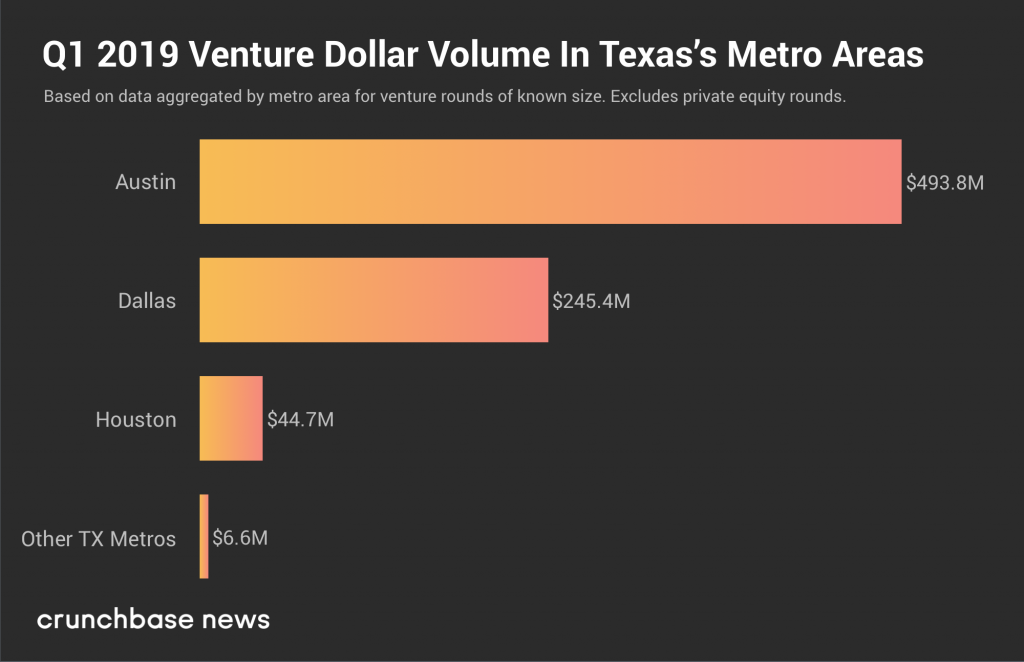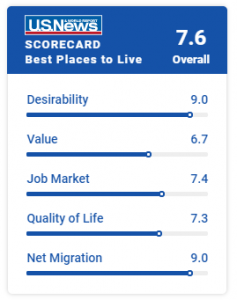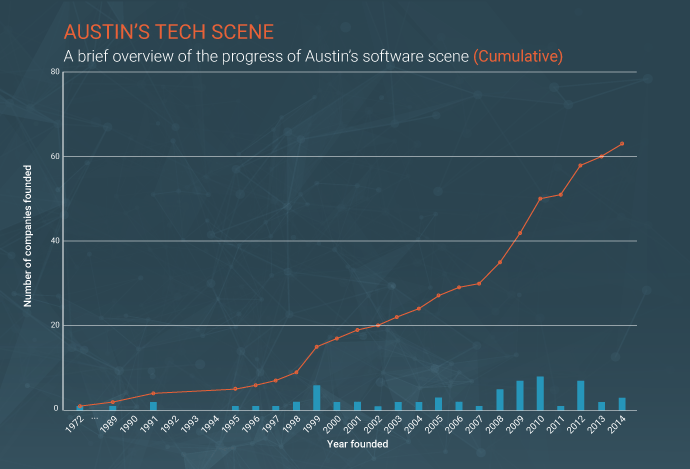The 2019 State of Web Developers in Austin [Infographic]

The 8th top city in the world for technology, the country’s fastest-growing major metro, and the #1 place to live — Austin, Texas, continues to be on the precipice of job growth and new opportunities.
» Stay tuned until the end to view our handy infographic summarizing all the information we’re about to cover. «
New Kid on the Block or Seasoned Veteran?
The city isn’t a rookie when it comes to global innovation and creativity. Since the 1980s, the capital has cultivated a strong tech following for many well-known companies including IBM, Dell, Motorola, and more.
Flash-forward thirty years later, and Austin, nicknamed “Silicon Hills,” has become one of the nation’s chief innovation hubs across various industries.
Note: Only software vendors on G2 Crowd with headquarters currently in the Austin area are included in graph.
Leading software companies like Google and Adobe, reigning telecommunications and mobile provider AT&T, and popular video game developers Blizzard Entertainment and BioWare, continue to put down roots in the region.
The Funding Forces Behind Local Innovation
A good indicator of technological growth for cities begins with startup and venture capital expansion. In the first quarter of 2019, venture capitalists invested $493.8 million into Austin startups alone across 34 deals, a 35 percent increase (in dollars) compared to last year.
 “While we’ve known for a while that Austin exemplifies what is possible outside the coasts, it’s great to see tech heavy hitters and the entrepreneurial ecosystem at-large start to know it, too,” said Mike Smerklo, co-founder and managing director of Austin-based Next Coast Ventures, in a recent Crunchbase article.
“While we’ve known for a while that Austin exemplifies what is possible outside the coasts, it’s great to see tech heavy hitters and the entrepreneurial ecosystem at-large start to know it, too,” said Mike Smerklo, co-founder and managing director of Austin-based Next Coast Ventures, in a recent Crunchbase article.
From early-stage seed funds to large-scale expansions, the city’s economical growth shows no signs of slowing down.
At the end of 2018, Apple announced a $1 billion investment to build a new campus in North Austin. Not lagging behind, this past March, Amazon reported plans to expand its Austin Tech Hub and create 800 new tech jobs.
Coding: The Job Skill of the Future
With over 1.5 billion websites on the internet today, 2.46 million Android apps, and 1.96 million applications on Apple’s App Store, web developers are serious multitaskers in the software world (and that’s barely scratching the tip of the iceberg).
The two main components of development are divided into:
- Back-End Development: commonly referred to as the “server-side”
- Responsibility: Everything that communicates between the database and the browser
- Programming Languages: Java, PHP, .Net (C#, VB), Ruby, Python, SQL, JavaScript
- Front-End Development: also known as the “client-side”
- Responsibility: Focuses on the look and feel of a site
- Programming Languages: HTML/CSS, JavaScript, jQuery
In the Austin-Round Rock area, there are 19,200 total employed software developers writing code, debugging work, ensuring data is safely secured, and designing interfaces.
The city’s tech culture and economy have, and continue to, propel this career path forward.
 In May, the Austin area unemployment rate hit 2.2 percent, a close contender to the record-breaking low set in 1999. As a whole, the state of Texas reached a historic rate of 3.5 percent, currently the lowest since documentation began in 1976.
In May, the Austin area unemployment rate hit 2.2 percent, a close contender to the record-breaking low set in 1999. As a whole, the state of Texas reached a historic rate of 3.5 percent, currently the lowest since documentation began in 1976.
Drew Scheberle, a senior vice president at the Austin Chamber of Commerce, stated to the Austin Business Journal, “Employers tell us they are still hiring great people at one of the fastest rates in the country. Austin area residents — new and old — have 50,000 open job opportunities to choose from.”
The Best-Paying Tech Jobs (And How Much They Pay in Austin)
New college graduates and individuals possessing in-demand skills have the chance to reach financial security in terms of paycheck and benefits. What type of skills are employers looking for, though?
Believe it or not, technical skills aren’t everything. According to a recent LinkedIn study, these are the top five soft skills companies are searching for:
- Creativity
- Persuasion
- Collaboration
- Adaptability
- Time Management
“As powerful as AI will ultimately become and is becoming, we’re still a ways away from computers being able to replicate and replace human interaction and human touch. So there’s a wonderful incentive for people to develop these skills because those jobs are going to be more stable for a longer period of time,” says Jeff Weiner, LinkedIn CEO.
Contrary to popular belief, developers don’t work alone. Instead, they constantly collaborate with others on a daily basis. While mastering fundamental programming languages is crucial, so is working well with team members.
Bizjournals breaks down the top five highest-paid tech positions for new graduates and their average annual salaries in Austin. Notice how web development is a great stepping stone into other tech branches within the industry and how hard skills don’t necessarily determine your level of success:
-
- Senior Developer
- Description: These individuals oversee coding and both web and app development projects.
- Required Skills: CSS, HTML5, JavaScript, JSON. Experience working with mobile-optimized web content and applications.
- Average National Salary: $109,957
- Average Salary in Austin: $85,677
- Lead Developer
- Description: Responsible for managing and monitoring a team of developers through product execution.
- Required Skills: Management and science. Experience participating in cooperative programming programs.
- Average National Salary: $103,237
- Average Salary in Austin: $96,250
- Mobile Developer
- Description: Similar related titles include Android Developer or iOS developer. Works on new applications for mobile devices.
- Required Skills: Mobile UI design, cross-platform app development, back-end development, modern language programming skills.
- Average National Salary: $92,654
- Average Salary in Austin: $103,100
- Data Scientist
- Description: Uses statistical analysis tools to review large amounts of data for valuable insights.
- Required Skills: IT, math, computational science, or related fields. Experience with metrics, analytics, statistics, and machine learning.
- Average National Salary: $88,813
- Average Salary in Austin: $90,450
- Product Manager
- Description: Leads the cross-functional team and is in charge of mapping different stages of development, launch, and maintenance.
- Required Skills: Business or related field, understanding code, time management, and interpersonal skills.
- Average National Salary: $87,947
- Average Salary in Austin: $79,166
- Senior Developer
Cost of Living for Austinites
Remember how Austin is the fastest-growing metro area in the country? Affordable prices on everyday items help locals, as well as those looking to move into the area, make the most out of their salary.
Although housing prices are a bit above the national median, residents benefit from no personal or corporate income taxes.
 It also helps that the region’s cost of living is three percent lower than the national average with low utility, grocery, and transportation fares compared to other major cities. U.S. News analyzed 125 metro areas in the United States to find the best places to live, and Austin came in first.
It also helps that the region’s cost of living is three percent lower than the national average with low utility, grocery, and transportation fares compared to other major cities. U.S. News analyzed 125 metro areas in the United States to find the best places to live, and Austin came in first.
With more than 138,000 tech-related jobs reported last year and a current average annual web developer salary of $81,690, skilled professionals can greatly benefit from being a part of one of the biggest innovative communities in the country.
Everyone Starts Somewhere: Taking the Leap
While having a degree will certainly provide in-depth context, it’s not the only route to take—the amount of available educational outlets are endless.
From an online coding boot camp, data analytics boot camp, coding programs, and local Austin computer classes, there are several avenues to kickstart a new career or advance your current skill set.
Take Silver Ehiwario, who had a degree, no prior coding experience, but a high interest in designing and developing software applications.
“I understand chemical processes and also have strong problem solving and critical thinking skills. I know how to take the next step and how things connect to each other. That helped me a lot in the boot camp.”

“I want to be creative. I want to develop software applications to improve businesses.”
The fast-paced program was overwhelming at times, but to counteract this Silver studied around-the-clock, practicing and reviewing exercises (all while expecting her third child). Not only that, but she was able to master crucial soft skills, specifically collaborating with others and understanding how different people view certain processes or products.
Upon graduating from the boot camp, she contacted Women Who Code and worked with them to open a nearby charter. Shortly after, in February, Silver landed an exciting new role at UniverseIT as a software developer.
In 2019, more than 23,000 developers graduated from a coding boot camp and that number of students only continues to grow. These in-person or virtual programs provide fast-paced curricula, real-time support, and career assistance.
Many online programs are also great resources to learn the fundamentals. Codecademy, Treehouse, Khan Academy, and FreeCodeCamp can help interested individuals determine if the tech field is something they’re serious about pursuing.
We’ve compiled all this data (and much more) for you in one helpful infographic. Take a look down below!
 Loading...
Loading...
Looking to become a web developer? Learn more about our online Coding Boot Camp at UT Austin.

 Live Chat
Live Chat
